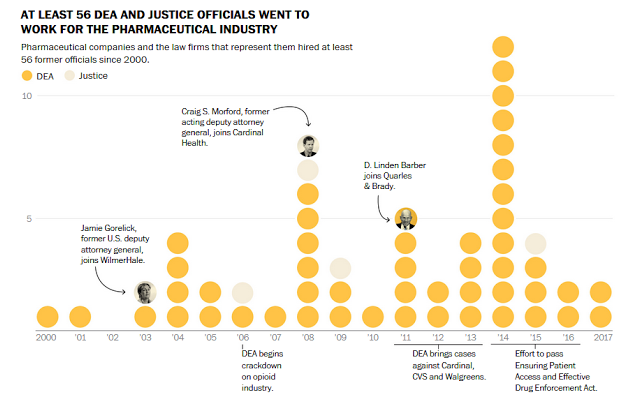
“I got the phone call Nov. 12 at 2:39 in the afternoon,” Tina Snyder recalled. Her 24-year-old son, Lee Winder, had been found in a shopping center parking lot near his car outside a Dunkin’ Donuts.
Winder had become addicted to pain pills and died of a heroin overdose.
Washington Post, “Amid a targeted lobbying effort, Congress weakened the DEA’s ability to go after drug distributors, even as opioid-related deaths continue to rise, a Washington Post and ‘60 Minutes’ investigation finds”, 15 Oct 2017:
In April 2016, at the height of the deadliest drug epidemic in U.S. history, Congress effectively stripped the Drug Enforcement Administration of its most potent weapon against large drug companies suspected of spilling prescription narcotics onto the nation’s streets.
By then, the opioid war had claimed 200,000 lives, more than three times the number of U.S. military deaths in the Vietnam War. Overdose deaths continue to rise. There is no end in sight.
A handful of members of Congress, allied with the nation’s major drug distributors, prevailed upon the DEA and the Justice Department to agree to a more industry-friendly law, undermining efforts to stanch the flow of pain pills, according to an investigation by The Washington Post and “60 Minutes.” The DEA had opposed the effort for years.
The law was the crowning achievement of a multifaceted campaign by the drug industry to weaken aggressive DEA enforcement efforts against drug distribution companies that were supplying corrupt doctors and pharmacists who peddled narcotics to the black market. The industry worked behind the scenes with lobbyists and key members of Congress, pouring more than a million dollars into their election campaigns.
The chief advocate of the law that hobbled the DEA was Rep. Tom Marino, a Pennsylvania Republican who is now President Trump’s nominee to become the nation’s next drug czar. Marino spent years trying to move the law through Congress. It passed after Sen. Orrin G. Hatch (R-Utah) negotiated a final version with the DEA.
For years, some drug distributors were fined for repeatedly ignoring warnings from the DEA to shut down suspicious sales of hundreds of millions of pills, while they racked up billions of dollars in sales.
The new law makes it virtually impossible for the DEA to freeze suspicious narcotic shipments from the companies, according to internal agency and Justice Department documents and an independent assessment by the DEA’s chief administrative law judge in a soon-to-be-published law review article. That powerful tool had allowed the agency to immediately prevent drugs from reaching the street.
Political action committees representing the industry contributed at least $1.5 million to the 23 lawmakers who sponsored or co-sponsored four versions of the bill, including nearly $100,000 to Marino and $177,000 to Hatch. Overall, the drug industry spent $102 million lobbying Congress on the bill and other legislation between 2014 and 2016, according to lobbying reports.
[TUESDAY UPDATE: Trump announces drug czar Marino will withdraw]
“The drug industry, the manufacturers, wholesalers, distributors and chain drugstores, have an influence over Congress that has never been seen before,” said Joseph T. Rannazzisi, who ran the DEA’s division responsible for regulating the drug industry and led a decade-long campaign of aggressive enforcement until he was forced out of the agency in 2015. “I mean, to get Congress to pass a bill to protect their interests in the height of an opioid epidemic just shows me how much influence they have.”
Besides the sponsors and co-sponsors of the bill, few lawmakers knew the true impact the law would have. It sailed through Congress and was passed by unanimous consent, a parliamentary procedure reserved for bills considered to be noncontroversial. The White House was equally unaware of the bill’s import when President Barack Obama signed it into law, according to interviews with former senior administration officials.
Top officials at the White House and the Justice Department have declined to discuss how the bill came to pass.
Michael Botticelli, who led the White House Office of National Drug Control Policy at the time, said neither Justice nor the DEA objected to the bill, removing a major obstacle to the president’s approval.
“We deferred to DEA, as is common practice,” he said.
The bill also was reviewed by the White House Office of Management and Budget.
“Neither the DEA nor the Justice Department informed OMB about the policy change in the bill,” a former senior OMB official with knowledge of the issue said recently. The official spoke on the condition of anonymity because of the sensitivity of internal White House deliberations.
The DEA’s top official at the time, acting administrator Chuck Rosenberg, declined repeated requests for interviews. A senior DEA official said the agency fought the bill for years in the face of growing pressure from key members of Congress and industry lobbyists. But the DEA lost the battle and eventually was forced to accept a deal it did not want.
[...]
Deeply involved in the effort to help the industry was the DEA’s former associate chief counsel, D. Linden Barber. While at the DEA, he helped design and carry out the early stages of the agency’s tough enforcement campaign, which targeted drug companies that were failing to report suspicious orders of narcotics.
When Barber went to work for the drug industry in 2011, he brought an intimate knowledge of the DEA’s strategy and how it could be attacked to protect the companies. He was one of dozens of DEA officials recruited by the drug industry during the past decade.
Barber played a key role in early version of the legislation that would eventually curtail the DEA’s power, according to an internal email written by a Justice Department official to a colleague. “He wrote the Marino bill,” the official wrote in 2014.
Barber declined repeated requests for an interview.
With a few words, the new law changed four decades of DEA practice. Previously, the DEA could freeze drug shipments that posed an “imminent danger” to the community, giving the agency broad authority. Now, the DEA must demonstrate that a company’s actions represent “a substantial likelihood of an immediate threat,” a much higher bar.
[...]
Today, Rannazzisi is a consultant for a team of lawyers suing the opioid industry. Separately, 41 state attorneys general have banded together to investigate the industry. Hundreds of counties, cities and towns also are suing.
“This is an industry that’s out of control. If they don’t follow the law in drug supply, and diversion occurs, people die. That’s just it, people die,” he said. “And what they’re saying is, ‘The heck with your compliance. We’ll just get the law changed.’ ”
[...]
‘Drug dealers in lab coats’
2006: 52,277 deaths from prescription opioid overdoses since 2000.
Joe Rannazzisi came to DEA headquarters as an outsider with an attitude. He worked as an agent in Detroit, where he watched prescription drugs flood small towns and cities in the Midwest.
Hundreds of millions of pain pills, such as Vicodin and oxycodone, ended up in the hands of dealers and illegal users.
Rogue doctors wrote fraudulent prescriptions for enormous numbers of pills, and complicit pharmacists filled them without question, often for cash. Internet pharmacies, supplied by drug distribution companies, allowed users to obtain drugs without seeing a doctor.
“There were just too many bad practitioners, too many bad pharmacies, and too many bad wholesalers and distributors,” Rannazzisi recalled.
[...]
Rannazzisi brought an aggressive approach to the diversion control office.
The year he took over, Linden Barber was promoted to run diversion control’s litigation office, which crafted the legal arguments that supported the team. He was a former Army lawyer who served in Iraq. The cadre of attorneys who worked for him saw him as a tough litigator unafraid of an influential industry.
Barber and Rannazzisi formed a powerful combination that the drug companies would learn to fear. “Early on he did really good work,” Rannazzisi said. “He jumped into the Internet cases when he first came here.”
After shutting down the Internet pharmacies, Rannazzisi and Barber pursued the pain management clinics that replaced them and soon became as ubiquitous in South Florida as the golden arches of McDonald’s. To get there, drug dealers and users would take the “Oxy Express” down Interstate 75.
“Lines of customers coming in and going out,” said Matthew Murphy, a veteran DEA supervisor in Boston whom Rannazzisi hired to be chief of pharmaceutical investigations. “Armed guards. Vanloads of people from the Appalachia region driving down to Florida to get a prescription from a pain clinic and then get the prescription filled, going back to wherever they’re from.”
Back home, each 30-pill vial of oxycodone was worth $900.
DEA officials realized they needed a new strategy to confront this new kind of drug dealer.
“They weren’t slinging crack on the corner,” Rannazzisi said. “These were professionals who were doing it. They were just drug dealers in lab coats.”
Rather than focusing on bad doctors and pharmacists, Rannazzisi and Barber decided to target the companies feeding the pill mills: the wholesale drug distributors, some of them massive multinational corporations.
[...]
“They definitely didn’t like Joe Rannazzisi,” Murphy said. “Not at all. He wasn’t viewed as a person that they could work with. And maybe that was appropriate. He didn’t want to work with industry much.”
Rannazzisi was unmoved by their complaints.
“We’re worried about their feelings being hurt because we were doing our job?” he said. “We were making them comply. We were holding their feet to the fire.”
Murphy recalled a telling meeting with drug company representatives.
He said the president of one of the drug companies sat on the other side of the table, put his hands up and said, “ ‘You got us. What can we do to make this right?’ ” Murphy recalled.
Murphy said he had heard the same thing from drug dealers.
There was an important difference, Murphy noted.
“You know,” he said, “the heroin and cocaine traffickers didn’t have a class ring on their finger from a prestigious university.”
‘This is war’
2011: 121,468 deaths from prescription opioid overdoses since 2000.
In 2011, Linden Barber left the DEA to join the Washington, D.C., office of the law firm Quarles & Brady. He started a practice representing drug companies. “If you have a DEA compliance issue or you’re facing a government investigation,” he said in a promotional video for the firm, “I’d be happy to hear from you.”
Barber’s move turned out to be a key moment in the struggle between drug companies and the government, but it was far from the only one. Dozens of top officials from the DEA and Justice Department have stepped through Washington’s revolving door to work for drug companies.

[...]
‘it was bad’
2013: 149,853 deaths from prescription opioid overdoses since 2000.
The field generals in the DEA’s war on opioids are men and women such as Jim Geldhof, a 43-year agency veteran who managed the diversion control program in the Detroit field office. He witnessed firsthand the heartbreak pain pills were causing across the Midwest.
One night, at a town hall meeting in Portsmouth, Ohio, Geldhof sat quietly as the Portsmouth High School gym fell dark and a large screen flickered with photographs.
Geldhof was in tears.
“Sons and daughters and grandsons and granddaughters in graduation pictures,” he recalled. “Some were wearing football jerseys. They had their whole lives ahead of them, and then they were gone.”
[...]
Geldhof, the DEA program manager in Detroit, was investigating a midsize Ohio-based drug distributor. Between 2007 and 2012, Miami-Luken had shipped 20 million doses of oxycodone and hydrocodone to pharmacies in West Virginia. About 11 million wound up in one county, Mingo, population 25,000.
Despite the rising death rate in West Virginia — the highest in the nation — Geldhof said his pleas in 2013 to halt Miami-Luken’s operations were ignored by the legal office at headquarters.
“First we got blown off by the company,” he said, “and then we got blown off by our own lawyers.”
Novak suspected another reason for the slowdown.
At times, he said, some of his colleagues appeared more concerned with pleasing the industry than working on behalf of the public. Some of the lawyers had simply given up fighting the industry and seemed to be preparing for a future working with the companies they were supposed to be regulating, he said.
“It was not just one person who left the office; everyone started to leave. That’s your payout. You do your time, and more and more people were auditioning for the industry. It stopped us from doing our jobs.”
The departures gave the industry an unfair advantage, Novak said.
“There was a fear,” he said. “It comes from seeing that some of the best and brightest former DEA attorneys are now on the other side and know all of the weak points. Their fingerprints are on memos and policy and emails.”
[...]
Epilogue
2016: 197,713 deaths from prescription opioid overdoses since 2000.
John Mulrooney, the chief DEA administrative law judge, has been documenting the falling number of immediate suspension orders against doctors, pharmacies and drug companies. That number has dropped from 65 in fiscal year 2011 to six so far this fiscal year, according to the DEA. Not a single order has targeted a distributor or manufacturer since late 2015, according to Mulrooney’s reports, which were obtained under the Freedom of Information Act.
Mulrooney said in his reports that the judges under him were handling so few cases at the DEA that they began hearing the cases of other federal agencies.
[...]
A spokesman for Whitehouse said that the DEA could have expressed its opposition at any time.
“The fact that it passed the entire Senate without hearing any sort of communication that would have triggered concern of at least one senator doesn’t really pass the smell test,” the spokesman said.
Jim Geldhof, the DEA program manager in Detroit, retired from the agency at the end of 2015 after 43 years on the job. He said the companies were fully aware of their responsibilities under the law.
“When you’re selling half a million pills to some pharmacy and you’re telling me that you don’t know what the rules are for a suspicious order?” said Geldhof, who is now working as a consultant to lawyers suing the industry. “All we were looking for is a good-faith effort by these companies to do the right thing, and there was no good-faith effort. Greed always trumped compliance. It did every time. It was about money, and it’s as simple as that.”
Just before Geldhof left, his two-year quest to persuade the DEA to take action against Miami-Luken finally paid off. In November 2015, the DEA accused the company of multiple violations of the law for allegedly failing to report orders for tens of millions of pain pills from pharmacies, most of them in West Virginia. That case — the most recent one to target a distributor — is pending.
Of the millions of pills sent to Mingo County, many went to one pharmacy in Williamson, the county seat, population 2,924. In one month alone, Miami-Luken shipped 258,000 hydrocodone pills to the pharmacy, more than 10 times the typical amount for a West Virginia pharmacy.
The mayor of Williamson has since filed a lawsuit against Miami-Luken and other drug distributors, accusing them of flooding the city with pain pills and permitting them to saturate the black market.
“Like sharks circling their prey, multi-billion dollar companies descended upon Appalachia for the sole purpose of profiting off of the prescription drug-fueled feeding frenzy,” the lawsuit says.

Posted by Jewish family making billions from opioid crisis on Wed, 18 Oct 2017 05:09 | #